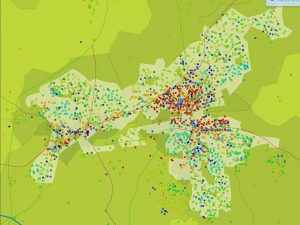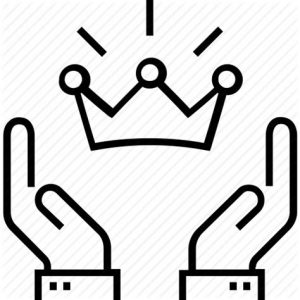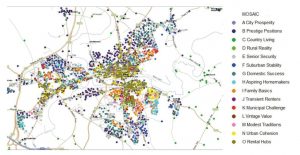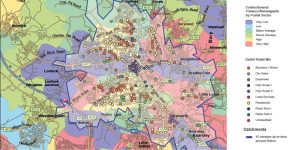Why carrying out catchment analysis will help provide the marketing insight to identify good business opportunities, align category management and reduce resource and budget wastage.
 Catchment is important for retailers and venues, it’s ‘the defined area around a store, site or venue that has a sphere of influence to draw in customers’. Your catchment size will be dependent on the nature of the business, the offering provided and availability from competitors in the local area.
Any business whether a large retailer or SME needs to understand their catchment area and underlying consumer demographics to align their product/service offering and improve targeting.
Catchment analysis provides key information about who lives within the local catchment, how far they are prepared to travel and what ranging, pricing and promotions will help to drive footfall and increase sales. For new businesses it can confirm viability whereas for existing stores or venues, it can highlight if the strategy needs to be redefined or tweaked in line with the target audience.
Catchment is important for retailers and venues, it’s ‘the defined area around a store, site or venue that has a sphere of influence to draw in customers’. Your catchment size will be dependent on the nature of the business, the offering provided and availability from competitors in the local area.
Any business whether a large retailer or SME needs to understand their catchment area and underlying consumer demographics to align their product/service offering and improve targeting.
Catchment analysis provides key information about who lives within the local catchment, how far they are prepared to travel and what ranging, pricing and promotions will help to drive footfall and increase sales. For new businesses it can confirm viability whereas for existing stores or venues, it can highlight if the strategy needs to be redefined or tweaked in line with the target audience.
 Socio-demographics – analysing consumer by age, life stage, education and income to help identify what customers look like, what they might be interested in, their disposable income and buying power.
Socio-demographics – analysing consumer by age, life stage, education and income to help identify what customers look like, what they might be interested in, their disposable income and buying power.
 Infrastructure – the surrounding transport network of roads, rail and public transport will indicate how accessible a location is. This accessibility will influence how far away your target audience might live and can impact how far they are prepared to travel for your offering.
Infrastructure – the surrounding transport network of roads, rail and public transport will indicate how accessible a location is. This accessibility will influence how far away your target audience might live and can impact how far they are prepared to travel for your offering.
 Competitor analysis – looks at the local businesses within your local area, the quantity, products and services offered and price point. These factors identify the potential level of demand for your products or services and can highlight or inform your own pricing or category ranging strategy.
Competitor analysis – looks at the local businesses within your local area, the quantity, products and services offered and price point. These factors identify the potential level of demand for your products or services and can highlight or inform your own pricing or category ranging strategy.
 Residential & workforce population – Your catchment will contain both residential and workforce populations. Your daytime footfall will therefore vary to that of night-time, based on the transient population either working or shopping within your catchment. The workforce population is important to consider as the number of businesses, size and industry type will also be influential on sales volumes and potential footfall.
Residential & workforce population – Your catchment will contain both residential and workforce populations. Your daytime footfall will therefore vary to that of night-time, based on the transient population either working or shopping within your catchment. The workforce population is important to consider as the number of businesses, size and industry type will also be influential on sales volumes and potential footfall.
 Once you understand your likely catchment area distance, the nature of the people that may be passing or using your venue, you can then discern the predominant profile or type of consumer you can attract.
For retailers the reason for shopping in your stores can determine category and ranging e.g. Tesco Express often have smaller convenience sized packaging for the impulse buys when in town or travelling home from work compared to a Tesco’s on a retail park which caters for the big family shop.
Restaurants in a low-income area may be more suited to good quality family meals rather than a la carte dining.
Hotels and Spa can align products and services in line with their target customer base from premium high end to value for money. through pricing and promotions. High end brands would not align themselves to Wowcher or Groupon, for other venues its a great means of filling quieter slots and raising exposure.
The type of customers you have in your local vicinity will impact the nature and pricing of the services and products you offer. It can also help drive more effective communications and promotions using this greater understanding of your audience to drive relevancy.
Once you understand your likely catchment area distance, the nature of the people that may be passing or using your venue, you can then discern the predominant profile or type of consumer you can attract.
For retailers the reason for shopping in your stores can determine category and ranging e.g. Tesco Express often have smaller convenience sized packaging for the impulse buys when in town or travelling home from work compared to a Tesco’s on a retail park which caters for the big family shop.
Restaurants in a low-income area may be more suited to good quality family meals rather than a la carte dining.
Hotels and Spa can align products and services in line with their target customer base from premium high end to value for money. through pricing and promotions. High end brands would not align themselves to Wowcher or Groupon, for other venues its a great means of filling quieter slots and raising exposure.
The type of customers you have in your local vicinity will impact the nature and pricing of the services and products you offer. It can also help drive more effective communications and promotions using this greater understanding of your audience to drive relevancy.
 Catchment analysis is a key part of identifying whether it is viable to open a new retail store or outlet in a particular location. It considers factors such as which target groups you are trying to reach, the footprint of the chosen area plus turnover potential in the existing locations.
It is worth spending time and resources on researching the chosen area to ensure that the new store will be profitable and will attract the required number of customers once open.Shopping centres vary for several different reasons, and consumers will often be prepared to travel outside of their local area to shop at a centre of their choice. Consumers will also be influenced by factors such as:
Catchment analysis is a key part of identifying whether it is viable to open a new retail store or outlet in a particular location. It considers factors such as which target groups you are trying to reach, the footprint of the chosen area plus turnover potential in the existing locations.
It is worth spending time and resources on researching the chosen area to ensure that the new store will be profitable and will attract the required number of customers once open.Shopping centres vary for several different reasons, and consumers will often be prepared to travel outside of their local area to shop at a centre of their choice. Consumers will also be influenced by factors such as:
 Once you understand who your customers will be and their motivations for coming to your business, you can align your marketing, promotions and pricing to increase sales uplift.
Catchment analysis is the means of gaining insight into your target audience and is fundamental for any business, retailer or venue, to be able to attract, engage and ultimately sell more effectively.
Related Links
Location Analysis and Location Planning
Visualisation for Catchment Analysis
For further information or to speak to one of our team call 01926 887555 or email I’m interested in a catchment analysis project
Once you understand who your customers will be and their motivations for coming to your business, you can align your marketing, promotions and pricing to increase sales uplift.
Catchment analysis is the means of gaining insight into your target audience and is fundamental for any business, retailer or venue, to be able to attract, engage and ultimately sell more effectively.
Related Links
Location Analysis and Location Planning
Visualisation for Catchment Analysis
For further information or to speak to one of our team call 01926 887555 or email I’m interested in a catchment analysis project
What is Catchment Analysis?
 Catchment is important for retailers and venues, it’s ‘the defined area around a store, site or venue that has a sphere of influence to draw in customers’. Your catchment size will be dependent on the nature of the business, the offering provided and availability from competitors in the local area.
Any business whether a large retailer or SME needs to understand their catchment area and underlying consumer demographics to align their product/service offering and improve targeting.
Catchment analysis provides key information about who lives within the local catchment, how far they are prepared to travel and what ranging, pricing and promotions will help to drive footfall and increase sales. For new businesses it can confirm viability whereas for existing stores or venues, it can highlight if the strategy needs to be redefined or tweaked in line with the target audience.
Catchment is important for retailers and venues, it’s ‘the defined area around a store, site or venue that has a sphere of influence to draw in customers’. Your catchment size will be dependent on the nature of the business, the offering provided and availability from competitors in the local area.
Any business whether a large retailer or SME needs to understand their catchment area and underlying consumer demographics to align their product/service offering and improve targeting.
Catchment analysis provides key information about who lives within the local catchment, how far they are prepared to travel and what ranging, pricing and promotions will help to drive footfall and increase sales. For new businesses it can confirm viability whereas for existing stores or venues, it can highlight if the strategy needs to be redefined or tweaked in line with the target audience.
Factor Influencing Catchment Area Size
The size of a business’s catchment area can be influenced by the format and size of a store, or the nature of the service. The number of businesses in the location can provide an additional pull for consumers such as shopping retail centres, which due to their size and number of stores can become ‘destinations’ for consumers. Consumers will be prepared to travel over an hour away for a shopping centre in comparison to their local high street or grocery store. Similarly, if you are looking to purchase high ticket priced items such as a new kitchen or sofa, you will often be happy to travel further to visit showrooms.Analysis performed within Catchment Analysis
 Socio-demographics – analysing consumer by age, life stage, education and income to help identify what customers look like, what they might be interested in, their disposable income and buying power.
Socio-demographics – analysing consumer by age, life stage, education and income to help identify what customers look like, what they might be interested in, their disposable income and buying power.
 Infrastructure – the surrounding transport network of roads, rail and public transport will indicate how accessible a location is. This accessibility will influence how far away your target audience might live and can impact how far they are prepared to travel for your offering.
Infrastructure – the surrounding transport network of roads, rail and public transport will indicate how accessible a location is. This accessibility will influence how far away your target audience might live and can impact how far they are prepared to travel for your offering.
 Competitor analysis – looks at the local businesses within your local area, the quantity, products and services offered and price point. These factors identify the potential level of demand for your products or services and can highlight or inform your own pricing or category ranging strategy.
Competitor analysis – looks at the local businesses within your local area, the quantity, products and services offered and price point. These factors identify the potential level of demand for your products or services and can highlight or inform your own pricing or category ranging strategy.
 Residential & workforce population – Your catchment will contain both residential and workforce populations. Your daytime footfall will therefore vary to that of night-time, based on the transient population either working or shopping within your catchment. The workforce population is important to consider as the number of businesses, size and industry type will also be influential on sales volumes and potential footfall.
Residential & workforce population – Your catchment will contain both residential and workforce populations. Your daytime footfall will therefore vary to that of night-time, based on the transient population either working or shopping within your catchment. The workforce population is important to consider as the number of businesses, size and industry type will also be influential on sales volumes and potential footfall.
Catchment Analysis to Align Product Offering
 Once you understand your likely catchment area distance, the nature of the people that may be passing or using your venue, you can then discern the predominant profile or type of consumer you can attract.
For retailers the reason for shopping in your stores can determine category and ranging e.g. Tesco Express often have smaller convenience sized packaging for the impulse buys when in town or travelling home from work compared to a Tesco’s on a retail park which caters for the big family shop.
Restaurants in a low-income area may be more suited to good quality family meals rather than a la carte dining.
Hotels and Spa can align products and services in line with their target customer base from premium high end to value for money. through pricing and promotions. High end brands would not align themselves to Wowcher or Groupon, for other venues its a great means of filling quieter slots and raising exposure.
The type of customers you have in your local vicinity will impact the nature and pricing of the services and products you offer. It can also help drive more effective communications and promotions using this greater understanding of your audience to drive relevancy.
Once you understand your likely catchment area distance, the nature of the people that may be passing or using your venue, you can then discern the predominant profile or type of consumer you can attract.
For retailers the reason for shopping in your stores can determine category and ranging e.g. Tesco Express often have smaller convenience sized packaging for the impulse buys when in town or travelling home from work compared to a Tesco’s on a retail park which caters for the big family shop.
Restaurants in a low-income area may be more suited to good quality family meals rather than a la carte dining.
Hotels and Spa can align products and services in line with their target customer base from premium high end to value for money. through pricing and promotions. High end brands would not align themselves to Wowcher or Groupon, for other venues its a great means of filling quieter slots and raising exposure.
The type of customers you have in your local vicinity will impact the nature and pricing of the services and products you offer. It can also help drive more effective communications and promotions using this greater understanding of your audience to drive relevancy.
Catchment Analysis for New Store Acquisition
 Catchment analysis is a key part of identifying whether it is viable to open a new retail store or outlet in a particular location. It considers factors such as which target groups you are trying to reach, the footprint of the chosen area plus turnover potential in the existing locations.
It is worth spending time and resources on researching the chosen area to ensure that the new store will be profitable and will attract the required number of customers once open.Shopping centres vary for several different reasons, and consumers will often be prepared to travel outside of their local area to shop at a centre of their choice. Consumers will also be influenced by factors such as:
Catchment analysis is a key part of identifying whether it is viable to open a new retail store or outlet in a particular location. It considers factors such as which target groups you are trying to reach, the footprint of the chosen area plus turnover potential in the existing locations.
It is worth spending time and resources on researching the chosen area to ensure that the new store will be profitable and will attract the required number of customers once open.Shopping centres vary for several different reasons, and consumers will often be prepared to travel outside of their local area to shop at a centre of their choice. Consumers will also be influenced by factors such as:
- Quality and mix of retail provision within the shopping centre
- Accessibility
- Parking
- Number of other retail stores
- Overall shopping environment
 Once you understand who your customers will be and their motivations for coming to your business, you can align your marketing, promotions and pricing to increase sales uplift.
Catchment analysis is the means of gaining insight into your target audience and is fundamental for any business, retailer or venue, to be able to attract, engage and ultimately sell more effectively.
Related Links
Location Analysis and Location Planning
Visualisation for Catchment Analysis
For further information or to speak to one of our team call 01926 887555 or email I’m interested in a catchment analysis project
Once you understand who your customers will be and their motivations for coming to your business, you can align your marketing, promotions and pricing to increase sales uplift.
Catchment analysis is the means of gaining insight into your target audience and is fundamental for any business, retailer or venue, to be able to attract, engage and ultimately sell more effectively.
Related Links
Location Analysis and Location Planning
Visualisation for Catchment Analysis
For further information or to speak to one of our team call 01926 887555 or email I’m interested in a catchment analysis project
